Spring is often associated with blooming flowers, warmer weather, and fresh air. For many, it’s a welcome relief from the dryness of winter. However, even as the seasons change, you’re not alone if your eyes still feel dry and irritated. Persistent dry eyes can be caused by various factors that extend beyond seasonal changes. At Eyes Harvest Hills in Edmonton, we understand the frustrations of dealing with dry eyes and are here to explain why this might be happening and how you can find relief.
Why Are My Eyes Still Dry in Spring?
Spring may bring higher humidity, but it also introduces environmental factors that can exacerbate dry eye symptoms. For example, spring’s windy conditions can accelerate the evaporation of tears, leaving your eyes parched. Additionally, the season is notorious for allergens like pollen, which can inflame your eyes and contribute to discomfort and redness. While many expect spring’s moisture to alleviate dryness, these factors can worsen symptoms.
For some, persistent dry eyes are caused by underlying health conditions such as meibomian gland dysfunction (MGD). This condition occurs when the glands in your eyelids become blocked, preventing them from releasing the oil needed to maintain a healthy tear film. Your tears evaporate too quickly without this oil, leaving your eyes dry and irritated. Other conditions like blepharitis (inflammation of the eyelids) or autoimmune diseases like Sjögren’s syndrome can also contribute to chronic dry eye symptoms.
Finally, modern lifestyle habits like prolonged screen time can exacerbate dry eyes. Reduced blinking while staring at screens leads to less moisture being distributed across your eyes, worsening dryness. Certain medications or poorly fitted contact lenses can also play a role, leaving many wondering why their eyes remain dry even as the seasons change.
Symptoms of Persistent Dry Eyes
Dry eyes can cause a variety of uncomfortable symptoms, which may persist even as spring arrives. Some of the most common include:
- A burning or stinging sensation.
- Redness and inflammation.
- A gritty feeling, as if something is in your eye.
- Sensitivity to light.
- Blurred vision, particularly after prolonged focus on screens or reading.
If you’re experiencing any of these symptoms, seeking professional care is important. Persistent dry eyes may not resolve independently, and treatment is often necessary to find lasting relief.
Advanced Dry Eye Treatments at Eyes Harvest Hills
At Eyes Harvest Hills, we offer cutting-edge treatments to address the root causes of dry eyes, providing effective relief for patients dealing with persistent discomfort. Some of the advanced solutions we offer include:
- BlephEx Treatment: This treatment targets and removes bacteria and debris from the eyelid margins, reducing inflammation and improving overall eye health.
- LipiFlow Treatment: Using gentle heat and pressure, LipiFlow clears blockages in the meibomian glands, helping restore normal oil production to your tears.
- Intense Pulsed Light (IPL) Therapy: IPL targets inflammation in the blood vessels around the eyelids, improving meibomian gland function and reducing symptoms.
- Low Light Level Therapy (LLLT): A non-invasive light treatment that reduces eyelid inflammation and promotes healthy tear production.
- ZEST Treatment: This exfoliating treatment helps remove debris and bacteria from the eyelids, improving tear quality and reducing irritation.
These treatments are tailored to each patient’s needs, ensuring effective and lasting relief from dry eyes.
What Can You Do at Home?
While professional treatment is often necessary for persistent dry eyes, there are steps you can take at home to help manage your symptoms.
- Stay Hydrated: Drink plenty of water throughout the day to support tear production.
- Protect Your Eyes: Wear sunglasses to shield your eyes from wind, pollen, and other environmental irritants.
- Take Breaks from Screens: Follow the 20-20-20 rule—every 20 minutes, look at something 20 feet away for at least 20 seconds to reduce eye strain.
- Use a Humidifier: Adding moisture to the air in your home can help prevent your eyes from drying out further.
These small changes can make a big difference in keeping your eyes comfortable.
If your eyes remain dry and irritated despite the seasonal changes, you may deal with more than just environmental dryness. Conditions like meibomian gland dysfunction, blepharitis, or lifestyle factors could be contributing to your discomfort. At Eyes Harvest Hills, we offer personalized care and advanced treatments to help you find relief and protect your eye health.
Don’t let dry eyes hold you back this spring. Contact Eyes Harvest Hills in Edmonton today to schedule an appointment and explore the treatment options that are right for you. You can enjoy the season with clear and comfortable vision with the right care.

